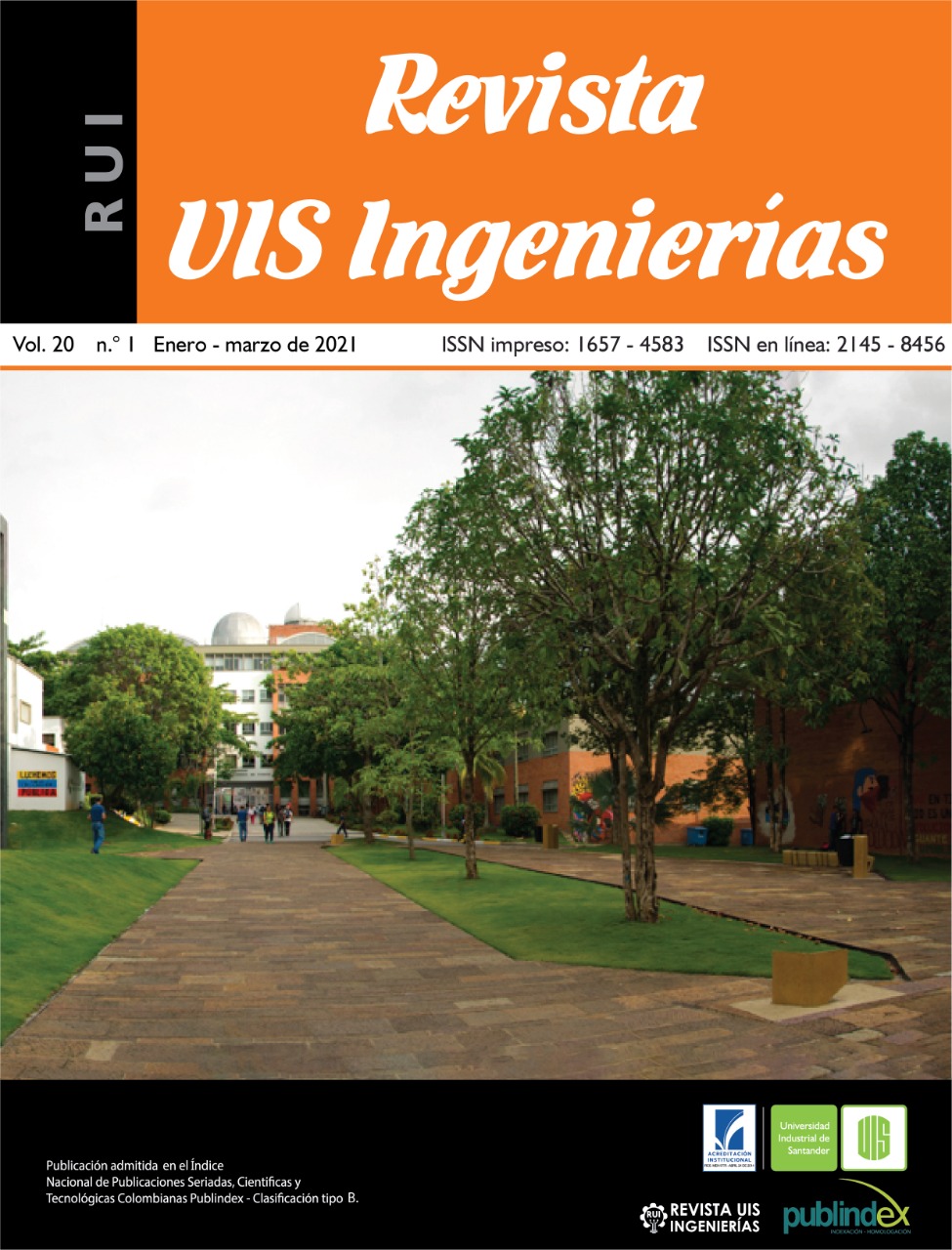Predictors of innovation in engineering and postgraduate programs using strategies based on digital platforms
Published 2020-11-18
Keywords
- innovation,
- predictor,
- digital platform,
- higher education,
- skills
How to Cite
Copyright (c) 2020 Revista UIS Ingenierías

This work is licensed under a Creative Commons Attribution-NoDerivatives 4.0 International License.
Abstract
The objective of the research was to determine the elements that constitute predictors of innovation in engineering and postgraduate programs, when using training strategies based on digital platforms. These media were the PLAD teaching support platform of the Francisco de Paula Santander University in Colombia, and the WhatsApp chat. We worked with a sample of 550 students from educational institutions in the city of Cúcuta and Arauca in Colombia, and Táchira and Maracaibo in Venezuela, belonging to Faculties of Engineering and Basic Sciences. It was a study under the quantitative paradigm, field design and correlational level, which resulted in a mathematical prediction model with the respective assessment of the significance of the variables considered predictors of innovation through the measure of variance with the Alpha of Cronbach. It is concluded that the development of innovation competences through the selected digital platforms is determined in the model by highly reliable variables, these being the development of logical thinking, methodological and research competence, and prior technical training of the student, yielding a coefficient of determination R2 of 0.95 in undergraduate, and 0.875 in postgraduate, at a significance level of 5%.
Downloads
References
[2] J. Cabero, M. Llorent, “La alfabetización digital de los alumnos, competencias digitales para el siglo XXI”, Revista Portuguesa de Pedagogía, vol. 42, no. 2, pp. 7-28, 2008, doi: 10.14195/1647-8614_42-2_1
[3] P. Carlino, “Alfabetización académica diez años después”, Revista Mexicana de Investigación Educativa, vol. 38, no. 57, pp. 355-381, 2013.
[4] B. Figueroa, M. Aillon, A. Fuentealba, “La escritura académica con soporte de esquemas digitales en la formación docente”, Revista de Universidad y Sociedad del Conocimiento (RUSC), vol. 11 no. 1, pp. 18-32, 2014, doi: 10.7238/rusc.v11i1.1665
[5] D. Marín, I. Garzón, F. Santamaría, “Choice of instructional design for the development of a learning environment in blended mode”, Revista Respuestas, vol. 24, no. 1, pp. 65-75, doi: 10.22463/0122820X.1808
[6] B. Gros, P. Lara, “Estrategias de innovación en la educación superior: el caso de la Universitat Oberta de Catalunya”, Revista Iberoamericana de Educación, vol. 1, no. 49, pp. 1-10, 2009.
[7] S. Unzueta, “Educación técnica, tecnológica y productiva para adultos desde una perspectiva neurodidáctica, crítica, reflexiva y propositiva”, Revista Integra Educativa, vol. 4, no. 1, pp. 85-115, 2011.
[8] C. Arias, “Las competencias comunicativas en la educación superior. Una experiencia etnográfica”, Revista Horizontes Pedagógicos, vol. 6, no. 1, pp. 1-15, 2004. [En línea]. Disponible en: https://horizontespedagogicos.ibero.edu.co/article/view/581
[9] A. Ortega, M. Vergel, J. Martinez, “Validity of microrubri, instrument to measure the development of competences in mathematics”, Journal of Physics: Conference Series 1160, pp. 1-6, 2019, doi: 10.1088/1742-6596/1160/1/012025
[10] H. Parra, J. Rojas, M. Vergel, “Curricular trends in the Universidad Francisco de Paula Santander academic program offerings”, Journal of Physics: conferences series 1329, p. 1-5, 2019. doi: doi:10.1088/1742-6596/1329/1/012013
[11] M. Vergel, J. Martínez, S. Zafra, “Apps en el rendimiento académico y auto concepto de estudiantes de ingeniería”, Revista Logos Ciencia & Tecnología, vol. 6, no. 1, pp. 198-208, 2015. [En línea]. Disponible en: https://dialnet.unirioja.es/servlet/articulo?codigo=6471187
[12] M. Fujioka, “U.S. writing center theory and practice: implications for writing centers in Japanese universities”, Kinki University Center for Liberal Arts and Foreign Languages Education Journal, vol. 2, no. 1, pp. 205-224, 2011.
[13] G. Hays, “Learners helping learners in an EFL writing center”, JALT2009 Conference Proceedings, vol. 17, no. 1, 2014. [En línea]. Disponible en: https://jalt-publications.org/archive/proceedings/2009/E013.pdf
[14] E. Aliste, M. Contreras, V. Sandoval, “Industrialización, desarrollo y ciudad: transformaciones socio-demográficas y espaciales en la geografía social del gran Concepción (1950-2010)”, Revista Invi, vol. 27, no. 75, pp. 21-71, 2012, doi: 10.4067/S0718-83582012000200002
[15] B. Tan, “Innovating writing centers and online writing labs outside North America”, The Asian EFL Journal Quarterly, vol. 13, no. 2, pp. 390-417, 2015.
[16] S. Palmas, “Digital technology as a tool for the democratization of powerful mathematical ideas”, Revista Colombiana de Educación, vol.74, no. 1, pp. 1-24, 2018.
[17] R. Hernández, C. Fernández, P. Baptista, Metodología de la investigación. México: McGraw Hill Education, 2014.
[18] H. Goldstein, Multilevel statistical models. London: Institute of Education, Multilevel Models Project, 1999.
[19] F. Murillo, “Los modelos multinivel como herramienta para la investigación educativa”, Magis: Revista Internacional de Investigación en Educación, vol. 1, no. 1, pp. 45-62, 2008.
[20] C. Werner, “Constructing Student Learning through Faculty Development: Writing Experts, Writing Centers, and Faculty Resources”, CEA Forum, College English Association, vol. 42, no. 2, pp. 79-92, 2013.
[21] C. Báez, C. Clunie, “El modelo tecnológico para la implementación de un proceso de educación ubicua en un ambiente de computación en la nube móvil”, Revista UIS Ingenierías, vol. 19, no. 4, pp. 77-88, 2020, doi: 10.18273/revuin.v19n4-2020007
[22] M. Vergel, J. Martínez, S. Zafra, “Validez de instrumento para medir la calidad de vida en la juventud: VIHDA”, Revista Logos Ciencia & Tecnología, vol. 7, no. 20, pp. 17-26, 2015.
[23] J. Martínez, M. Vergel, S. Zafra, Comportamiento juvenil y competencias prosociales. Bogotá: Grupo Editorial Ibáñez, 2016.
[24] M. Santamaria, V, Ramon. “Stop-motion como componente didáctico-tecnológico para reducir el consumo de alcohol en estudiantes de ingeniería”, Aibi, Revista de Investigación, Administración e Ingeniería, vol. 7, no. 2, pp. 88-94, doi: 10.15649/2346030X.579
[25] J. Nieto, J. Rojas, M. Vergel, Impacto de estrategia pedagógica basada en el aprendizaje creativo para estudiantes de ingeniería. Bogotá: Grupo Editorial Ibáñez, 2019.
[26] M. Latorre, E. Flórez, J. Serrano, “Desarrollo de un software académico para el cálculo de carga térmica para la asignatura de aires acondicionados en la Universidad de Pamplona”, Revista UIS Ingenierías, vol. 19, no. 3, pp. 87-96, 2020. doi: 10.18273/revuin.v19n3-2020009
[27] A. Pineda. Una cultura de la tutoría: Fundamentación de un sistema de tutorías desde el programa Taller de Lenguaje de la FUAC. Bogotá: Pontificia Universidad Javeriana, 2015.

